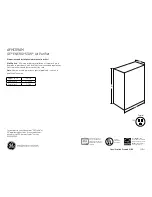
4.5 – Belt Tension Adjustment.
To adjust belt tension:
1. Loosen fan motor bolts.
2. Adjust belt tension by sliding the motor on the mounting base.
3. Tighten nuts.
4. Adjust bolts and nut on mounting plate to secure motor in fixed position.
4.6 – Condenser-Fan Adjustment
1. Shut off unit power supply.
2. Remove fan top-grille assembly and loosen fan hub screws.
3. Adjust fan height on unit, using a straightedge placed across the fan orifice.
4. Tighten setscrews
Fig. 10 Condenser – Fan Adjustment
4.7 – Refrigerant Charge
Amount of refrigerant charge is listed on unit nameplate and in Table 1. Refer to Carrier GTAC II; Module 5;
Charging, Recovery, Recycling, and Reclamation section for charging methods and procedures. Unit panels must be
in place when unit is operating during charging procedure.
NOTE: Do not use recycled refrigerant as it may contain contaminants.
NO CHARGE — Use standard evacuating techniques. After evacuating system, weight in the specified amount of
refrigerant (refer to Table 1).
LOW CHARGE COOLING — Using cooling charging chart according to the size of the unit Add or remove refrigerant
until conditions of the chart are met. Note that charging chart is different from those normally used. An accurate
pressure gage and temperature-sensing device is required. Charging is accomplished by ensuring the proper amount
of liquid sub-cooling. Measure liquid line pressure at the liquid line service valve using pressure gage.
Connect temperature sensing device to the liquid line near the liquid line service valve and insulate it so that outdoor
ambient temperature does not affect reading.
TO USE THE COOLING CHARGING CHART — Use the above temperature and pressure readings, and find the
intersection point on the cooling charging chart. If intersection point on chart is above line, add refrigerant. If
intersection point on chart is below line, carefully recover some of the charge. Recheck suction pressure as charge
is adjusted.
NOTE: Indoor-air CFM must be within normal operating range of unit. All outdoor fans must be operating.
Page 20
Содержание 50TCM Series
Страница 6: ... LPHQVLRQV 7 8 85 6 76 0 16 216 7 007 Page 6 ...
Страница 8: ... 85 6 76 0 16 216 7 0 LPHQVLRQV 7 5 5 Page 8 ...
Страница 10: ... LPHQVLRQV 7 85 6 76 0 16 216 7 0 5 5 Page 10 ...
Страница 24: ...Typical Wiring Schematic 50TCMA07 400V Page 24 ...
Страница 25: ...Typical Wiring Schematic 50TCMD08 09 400V Page 25 ...
Страница 26: ...Typical Wiring Schematic 50TCMD12 14 400V Page 26 ...
Страница 27: ...Typical Control Schematic 50TCMA Series Page 27 ...
Страница 28: ...Typical Control Schematic 50TCMD Series Page 28 ...
Страница 32: ...Charging Chart 400V 50Hz 50TCMA07 Charging Chart 400V 50Hz 50TCMD08 CIR 1 Page 32 ...
Страница 33: ...Charging Chart 400V 50Hz 50TCMD08 CIR 2 Charging Chart 400V 50Hz 50TCMD09 CIR 1 Page 33 ...
Страница 34: ...Charging Chart 400V 50Hz 50TCMD09 CIR 2 Charging Chart 400V 50Hz 50TCMD12 CIR 1 Page 34 ...
Страница 35: ...Charging Chart 400V 50Hz 50TCMD12 CIR 2 Charging Chart 400V 50Hz 50TCMD14 CIR 1 Page 35 ...
Страница 36: ...Charging Chart 400V 50Hz 50TCMD14 CIR 2 Page 36 ...
















































